Organisational Behaviour Report: ASDA's Culture, Motivation and Teams
VerifiedAdded on 2021/01/01
|12
|3334
|228
Report
AI Summary
This report analyzes the organizational behavior within ASDA, a British supermarket retailer. It examines the influence of organizational culture, power dynamics, and politics on individual and team performance, referencing Charles Handy's culture model and various types of organizational power. The report delves into content (Maslow's hierarchy) and process theories of motivation (Vroom's expectancy theory), exploring how these techniques facilitate goal achievement. Furthermore, it differentiates between effective and ineffective teams, outlining characteristics that contribute to each. The report concludes by summarizing key concepts and philosophies of organizational behavior within the context of ASDA, providing a comprehensive overview of the subject matter.
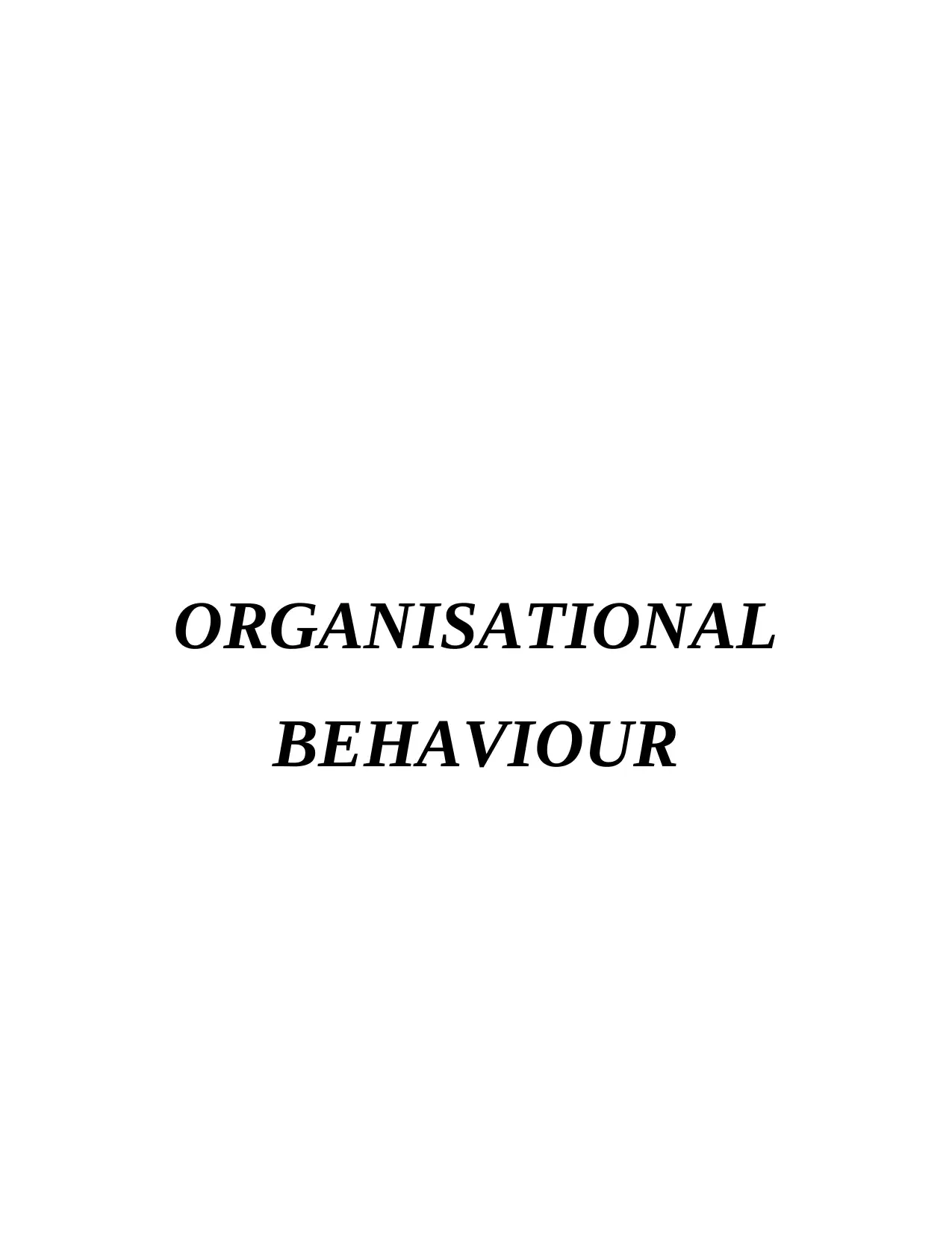
ORGANISATIONAL
BEHAVIOUR
BEHAVIOUR
Paraphrase This Document
Need a fresh take? Get an instant paraphrase of this document with our AI Paraphraser
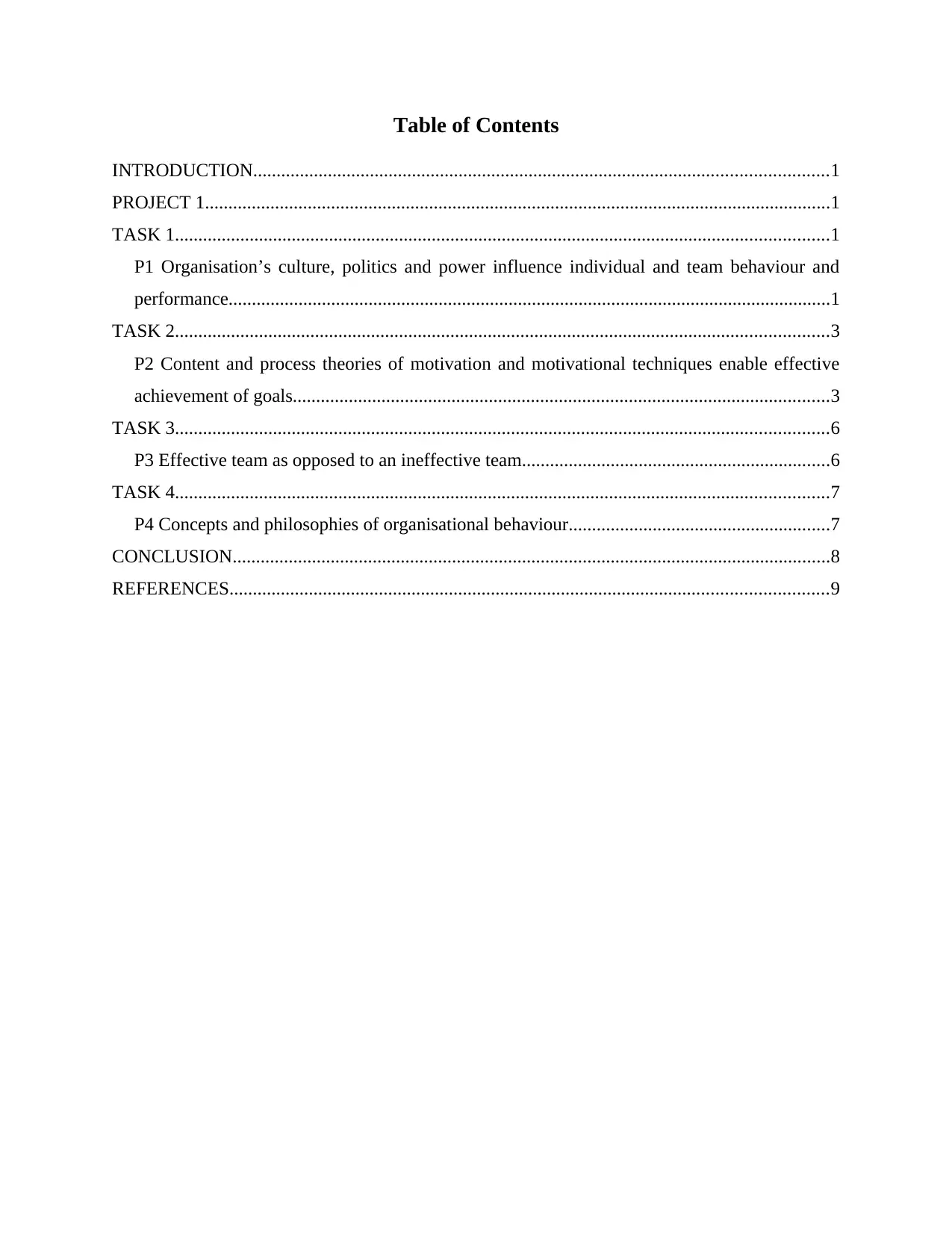
Table of Contents
INTRODUCTION...........................................................................................................................1
PROJECT 1......................................................................................................................................1
TASK 1............................................................................................................................................1
P1 Organisation’s culture, politics and power influence individual and team behaviour and
performance.................................................................................................................................1
TASK 2............................................................................................................................................3
P2 Content and process theories of motivation and motivational techniques enable effective
achievement of goals...................................................................................................................3
TASK 3............................................................................................................................................6
P3 Effective team as opposed to an ineffective team..................................................................6
TASK 4............................................................................................................................................7
P4 Concepts and philosophies of organisational behaviour........................................................7
CONCLUSION................................................................................................................................8
REFERENCES................................................................................................................................9
INTRODUCTION...........................................................................................................................1
PROJECT 1......................................................................................................................................1
TASK 1............................................................................................................................................1
P1 Organisation’s culture, politics and power influence individual and team behaviour and
performance.................................................................................................................................1
TASK 2............................................................................................................................................3
P2 Content and process theories of motivation and motivational techniques enable effective
achievement of goals...................................................................................................................3
TASK 3............................................................................................................................................6
P3 Effective team as opposed to an ineffective team..................................................................6
TASK 4............................................................................................................................................7
P4 Concepts and philosophies of organisational behaviour........................................................7
CONCLUSION................................................................................................................................8
REFERENCES................................................................................................................................9
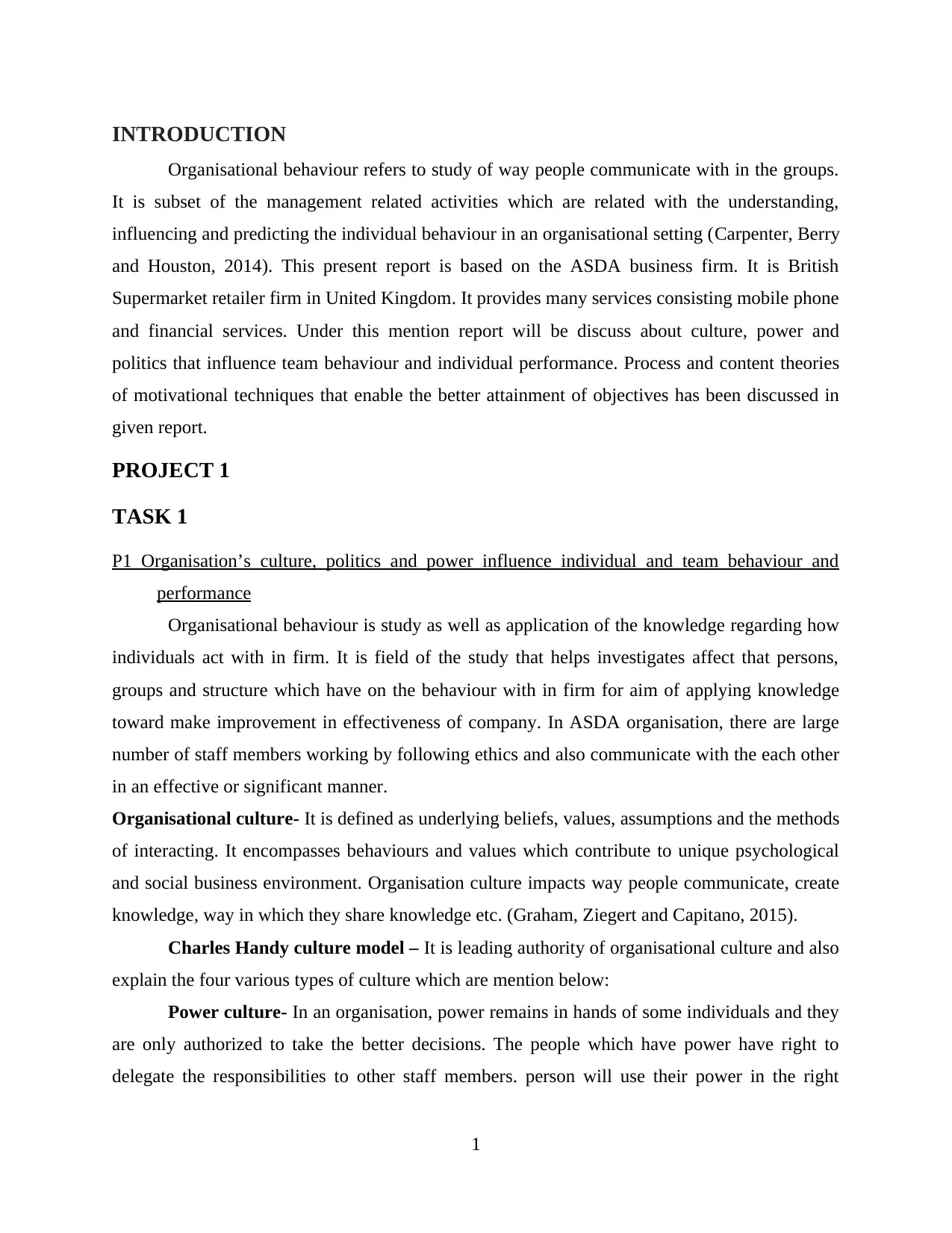
INTRODUCTION
Organisational behaviour refers to study of way people communicate with in the groups.
It is subset of the management related activities which are related with the understanding,
influencing and predicting the individual behaviour in an organisational setting (Carpenter, Berry
and Houston, 2014). This present report is based on the ASDA business firm. It is British
Supermarket retailer firm in United Kingdom. It provides many services consisting mobile phone
and financial services. Under this mention report will be discuss about culture, power and
politics that influence team behaviour and individual performance. Process and content theories
of motivational techniques that enable the better attainment of objectives has been discussed in
given report.
PROJECT 1
TASK 1
P1 Organisation’s culture, politics and power influence individual and team behaviour and
performance
Organisational behaviour is study as well as application of the knowledge regarding how
individuals act with in firm. It is field of the study that helps investigates affect that persons,
groups and structure which have on the behaviour with in firm for aim of applying knowledge
toward make improvement in effectiveness of company. In ASDA organisation, there are large
number of staff members working by following ethics and also communicate with the each other
in an effective or significant manner.
Organisational culture- It is defined as underlying beliefs, values, assumptions and the methods
of interacting. It encompasses behaviours and values which contribute to unique psychological
and social business environment. Organisation culture impacts way people communicate, create
knowledge, way in which they share knowledge etc. (Graham, Ziegert and Capitano, 2015).
Charles Handy culture model – It is leading authority of organisational culture and also
explain the four various types of culture which are mention below:
Power culture- In an organisation, power remains in hands of some individuals and they
are only authorized to take the better decisions. The people which have power have right to
delegate the responsibilities to other staff members. person will use their power in the right
1
Organisational behaviour refers to study of way people communicate with in the groups.
It is subset of the management related activities which are related with the understanding,
influencing and predicting the individual behaviour in an organisational setting (Carpenter, Berry
and Houston, 2014). This present report is based on the ASDA business firm. It is British
Supermarket retailer firm in United Kingdom. It provides many services consisting mobile phone
and financial services. Under this mention report will be discuss about culture, power and
politics that influence team behaviour and individual performance. Process and content theories
of motivational techniques that enable the better attainment of objectives has been discussed in
given report.
PROJECT 1
TASK 1
P1 Organisation’s culture, politics and power influence individual and team behaviour and
performance
Organisational behaviour is study as well as application of the knowledge regarding how
individuals act with in firm. It is field of the study that helps investigates affect that persons,
groups and structure which have on the behaviour with in firm for aim of applying knowledge
toward make improvement in effectiveness of company. In ASDA organisation, there are large
number of staff members working by following ethics and also communicate with the each other
in an effective or significant manner.
Organisational culture- It is defined as underlying beliefs, values, assumptions and the methods
of interacting. It encompasses behaviours and values which contribute to unique psychological
and social business environment. Organisation culture impacts way people communicate, create
knowledge, way in which they share knowledge etc. (Graham, Ziegert and Capitano, 2015).
Charles Handy culture model – It is leading authority of organisational culture and also
explain the four various types of culture which are mention below:
Power culture- In an organisation, power remains in hands of some individuals and they
are only authorized to take the better decisions. The people which have power have right to
delegate the responsibilities to other staff members. person will use their power in the right
1
⊘ This is a preview!⊘
Do you want full access?
Subscribe today to unlock all pages.

Trusted by 1+ million students worldwide
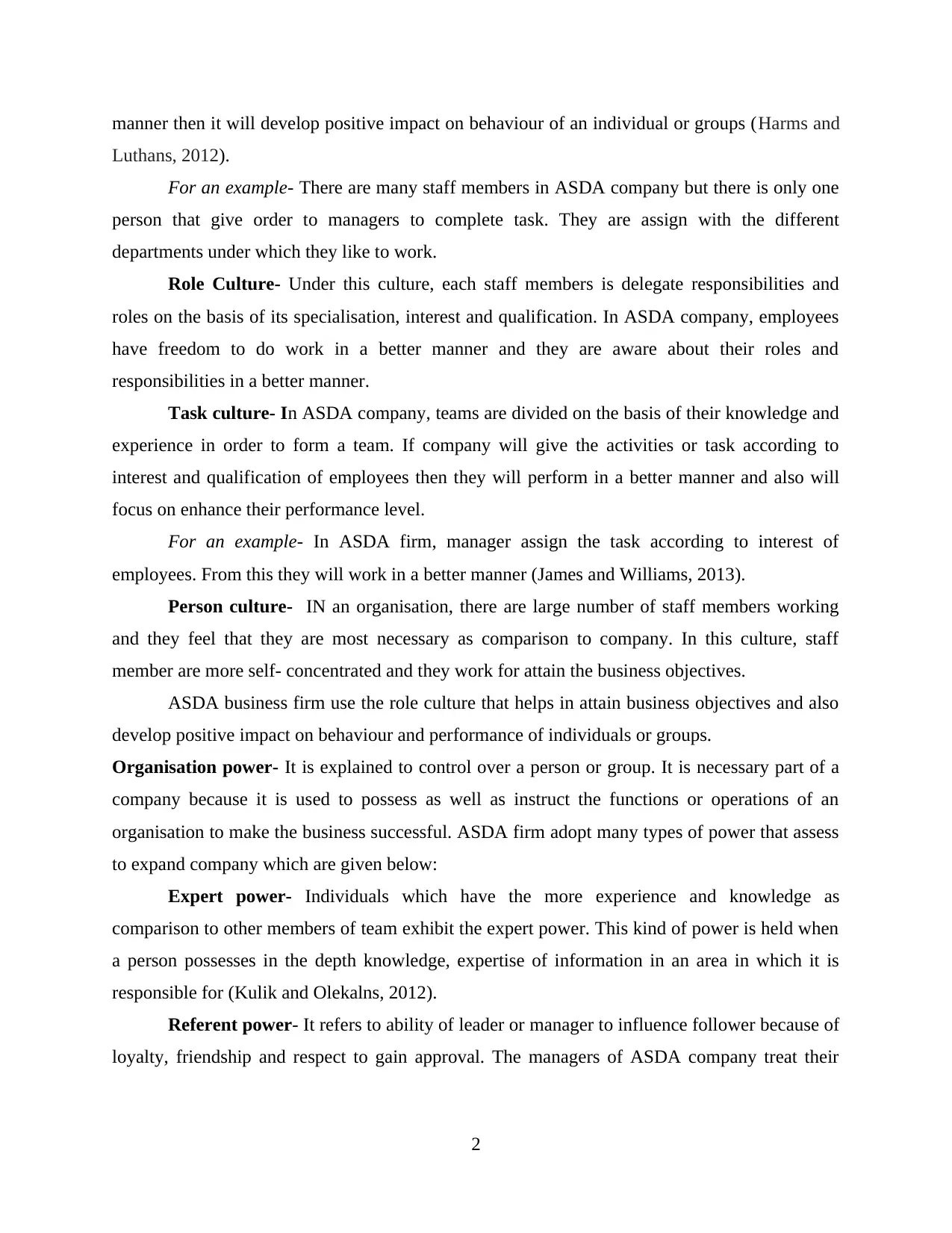
manner then it will develop positive impact on behaviour of an individual or groups (Harms and
Luthans, 2012).
For an example- There are many staff members in ASDA company but there is only one
person that give order to managers to complete task. They are assign with the different
departments under which they like to work.
Role Culture- Under this culture, each staff members is delegate responsibilities and
roles on the basis of its specialisation, interest and qualification. In ASDA company, employees
have freedom to do work in a better manner and they are aware about their roles and
responsibilities in a better manner.
Task culture- In ASDA company, teams are divided on the basis of their knowledge and
experience in order to form a team. If company will give the activities or task according to
interest and qualification of employees then they will perform in a better manner and also will
focus on enhance their performance level.
For an example- In ASDA firm, manager assign the task according to interest of
employees. From this they will work in a better manner (James and Williams, 2013).
Person culture- IN an organisation, there are large number of staff members working
and they feel that they are most necessary as comparison to company. In this culture, staff
member are more self- concentrated and they work for attain the business objectives.
ASDA business firm use the role culture that helps in attain business objectives and also
develop positive impact on behaviour and performance of individuals or groups.
Organisation power- It is explained to control over a person or group. It is necessary part of a
company because it is used to possess as well as instruct the functions or operations of an
organisation to make the business successful. ASDA firm adopt many types of power that assess
to expand company which are given below:
Expert power- Individuals which have the more experience and knowledge as
comparison to other members of team exhibit the expert power. This kind of power is held when
a person possesses in the depth knowledge, expertise of information in an area in which it is
responsible for (Kulik and Olekalns, 2012).
Referent power- It refers to ability of leader or manager to influence follower because of
loyalty, friendship and respect to gain approval. The managers of ASDA company treat their
2
Luthans, 2012).
For an example- There are many staff members in ASDA company but there is only one
person that give order to managers to complete task. They are assign with the different
departments under which they like to work.
Role Culture- Under this culture, each staff members is delegate responsibilities and
roles on the basis of its specialisation, interest and qualification. In ASDA company, employees
have freedom to do work in a better manner and they are aware about their roles and
responsibilities in a better manner.
Task culture- In ASDA company, teams are divided on the basis of their knowledge and
experience in order to form a team. If company will give the activities or task according to
interest and qualification of employees then they will perform in a better manner and also will
focus on enhance their performance level.
For an example- In ASDA firm, manager assign the task according to interest of
employees. From this they will work in a better manner (James and Williams, 2013).
Person culture- IN an organisation, there are large number of staff members working
and they feel that they are most necessary as comparison to company. In this culture, staff
member are more self- concentrated and they work for attain the business objectives.
ASDA business firm use the role culture that helps in attain business objectives and also
develop positive impact on behaviour and performance of individuals or groups.
Organisation power- It is explained to control over a person or group. It is necessary part of a
company because it is used to possess as well as instruct the functions or operations of an
organisation to make the business successful. ASDA firm adopt many types of power that assess
to expand company which are given below:
Expert power- Individuals which have the more experience and knowledge as
comparison to other members of team exhibit the expert power. This kind of power is held when
a person possesses in the depth knowledge, expertise of information in an area in which it is
responsible for (Kulik and Olekalns, 2012).
Referent power- It refers to ability of leader or manager to influence follower because of
loyalty, friendship and respect to gain approval. The managers of ASDA company treat their
2
Paraphrase This Document
Need a fresh take? Get an instant paraphrase of this document with our AI Paraphraser
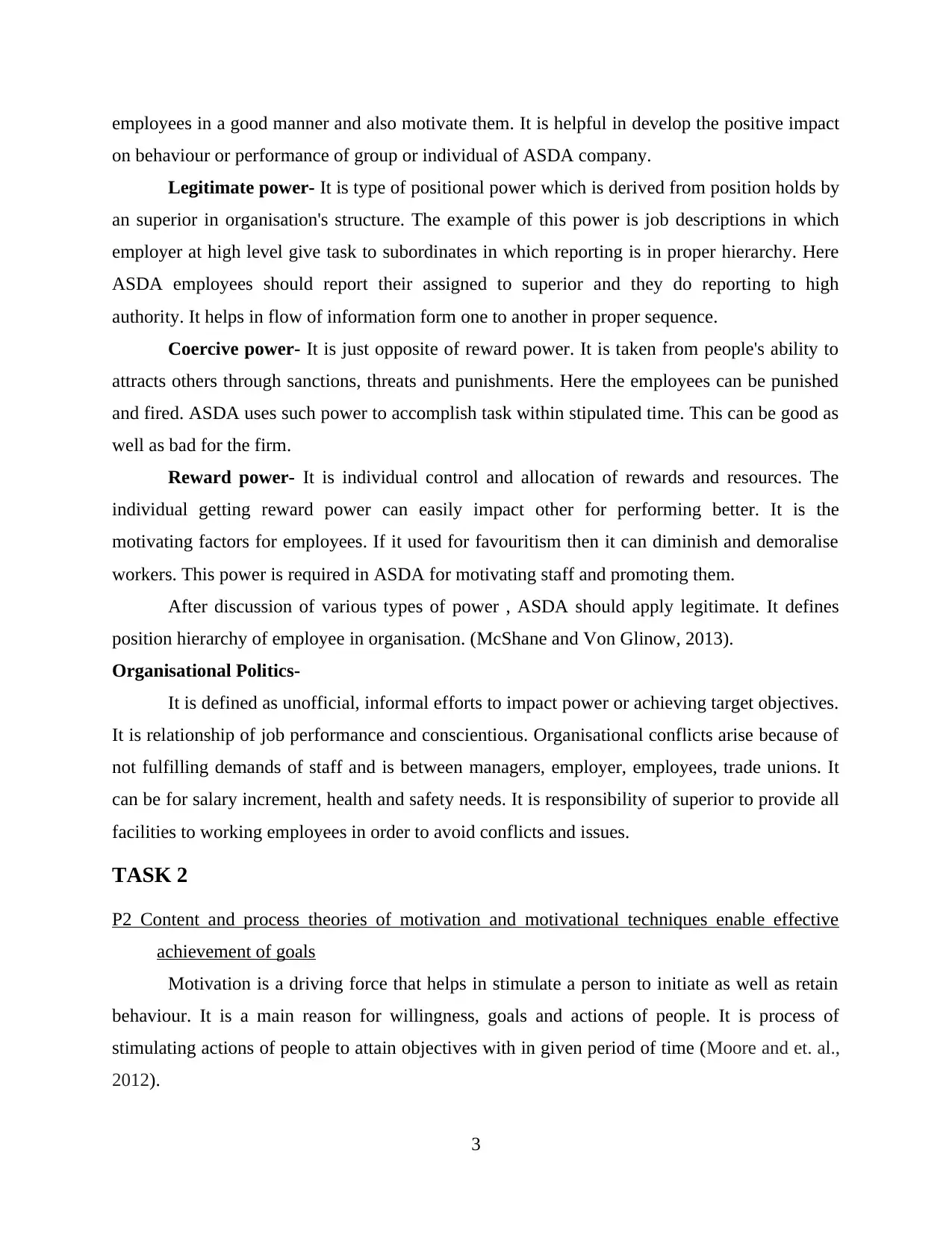
employees in a good manner and also motivate them. It is helpful in develop the positive impact
on behaviour or performance of group or individual of ASDA company.
Legitimate power- It is type of positional power which is derived from position holds by
an superior in organisation's structure. The example of this power is job descriptions in which
employer at high level give task to subordinates in which reporting is in proper hierarchy. Here
ASDA employees should report their assigned to superior and they do reporting to high
authority. It helps in flow of information form one to another in proper sequence.
Coercive power- It is just opposite of reward power. It is taken from people's ability to
attracts others through sanctions, threats and punishments. Here the employees can be punished
and fired. ASDA uses such power to accomplish task within stipulated time. This can be good as
well as bad for the firm.
Reward power- It is individual control and allocation of rewards and resources. The
individual getting reward power can easily impact other for performing better. It is the
motivating factors for employees. If it used for favouritism then it can diminish and demoralise
workers. This power is required in ASDA for motivating staff and promoting them.
After discussion of various types of power , ASDA should apply legitimate. It defines
position hierarchy of employee in organisation. (McShane and Von Glinow, 2013).
Organisational Politics-
It is defined as unofficial, informal efforts to impact power or achieving target objectives.
It is relationship of job performance and conscientious. Organisational conflicts arise because of
not fulfilling demands of staff and is between managers, employer, employees, trade unions. It
can be for salary increment, health and safety needs. It is responsibility of superior to provide all
facilities to working employees in order to avoid conflicts and issues.
TASK 2
P2 Content and process theories of motivation and motivational techniques enable effective
achievement of goals
Motivation is a driving force that helps in stimulate a person to initiate as well as retain
behaviour. It is a main reason for willingness, goals and actions of people. It is process of
stimulating actions of people to attain objectives with in given period of time (Moore and et. al.,
2012).
3
on behaviour or performance of group or individual of ASDA company.
Legitimate power- It is type of positional power which is derived from position holds by
an superior in organisation's structure. The example of this power is job descriptions in which
employer at high level give task to subordinates in which reporting is in proper hierarchy. Here
ASDA employees should report their assigned to superior and they do reporting to high
authority. It helps in flow of information form one to another in proper sequence.
Coercive power- It is just opposite of reward power. It is taken from people's ability to
attracts others through sanctions, threats and punishments. Here the employees can be punished
and fired. ASDA uses such power to accomplish task within stipulated time. This can be good as
well as bad for the firm.
Reward power- It is individual control and allocation of rewards and resources. The
individual getting reward power can easily impact other for performing better. It is the
motivating factors for employees. If it used for favouritism then it can diminish and demoralise
workers. This power is required in ASDA for motivating staff and promoting them.
After discussion of various types of power , ASDA should apply legitimate. It defines
position hierarchy of employee in organisation. (McShane and Von Glinow, 2013).
Organisational Politics-
It is defined as unofficial, informal efforts to impact power or achieving target objectives.
It is relationship of job performance and conscientious. Organisational conflicts arise because of
not fulfilling demands of staff and is between managers, employer, employees, trade unions. It
can be for salary increment, health and safety needs. It is responsibility of superior to provide all
facilities to working employees in order to avoid conflicts and issues.
TASK 2
P2 Content and process theories of motivation and motivational techniques enable effective
achievement of goals
Motivation is a driving force that helps in stimulate a person to initiate as well as retain
behaviour. It is a main reason for willingness, goals and actions of people. It is process of
stimulating actions of people to attain objectives with in given period of time (Moore and et. al.,
2012).
3
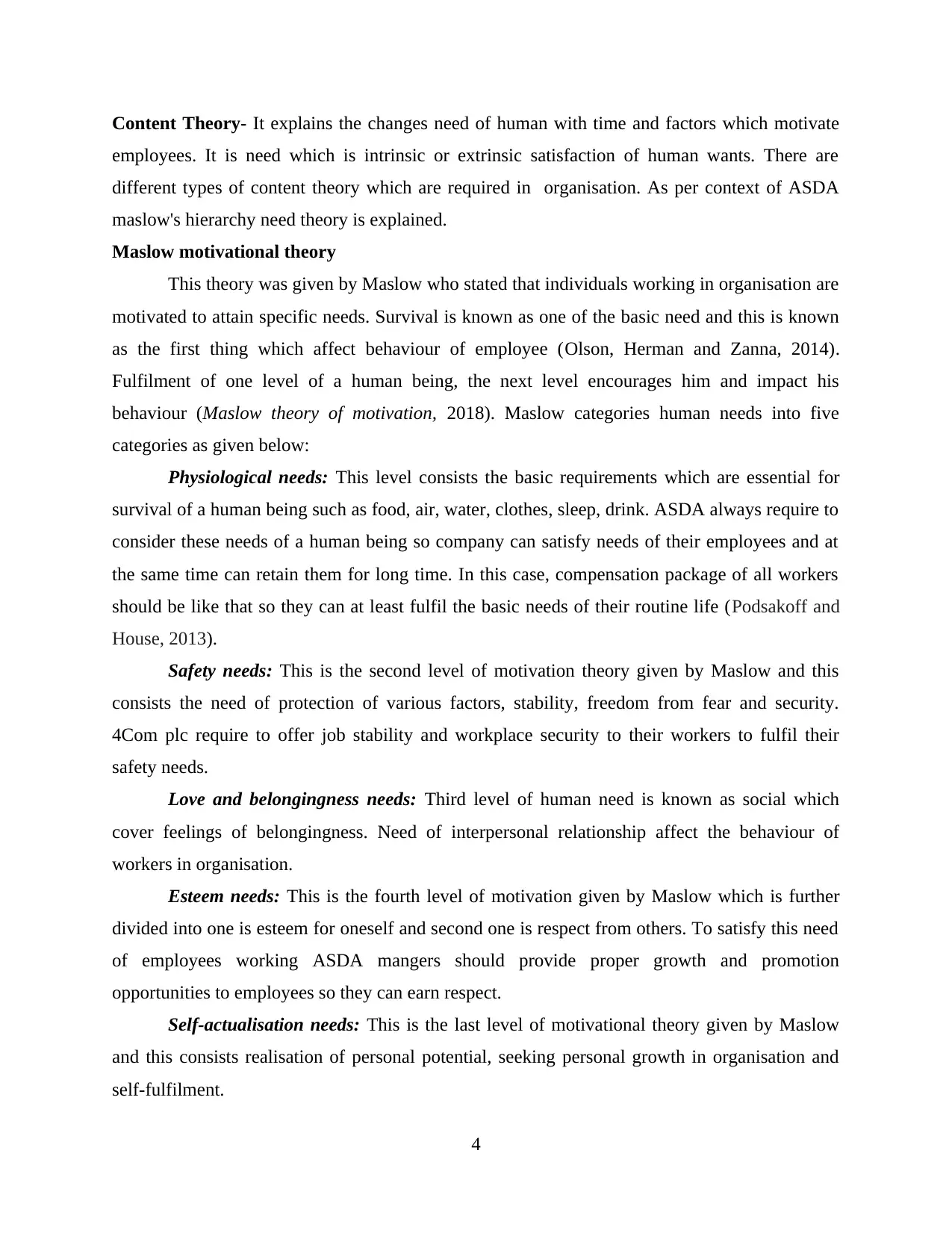
Content Theory- It explains the changes need of human with time and factors which motivate
employees. It is need which is intrinsic or extrinsic satisfaction of human wants. There are
different types of content theory which are required in organisation. As per context of ASDA
maslow's hierarchy need theory is explained.
Maslow motivational theory
This theory was given by Maslow who stated that individuals working in organisation are
motivated to attain specific needs. Survival is known as one of the basic need and this is known
as the first thing which affect behaviour of employee (Olson, Herman and Zanna, 2014).
Fulfilment of one level of a human being, the next level encourages him and impact his
behaviour (Maslow theory of motivation, 2018). Maslow categories human needs into five
categories as given below:
Physiological needs: This level consists the basic requirements which are essential for
survival of a human being such as food, air, water, clothes, sleep, drink. ASDA always require to
consider these needs of a human being so company can satisfy needs of their employees and at
the same time can retain them for long time. In this case, compensation package of all workers
should be like that so they can at least fulfil the basic needs of their routine life (Podsakoff and
House, 2013).
Safety needs: This is the second level of motivation theory given by Maslow and this
consists the need of protection of various factors, stability, freedom from fear and security.
4Com plc require to offer job stability and workplace security to their workers to fulfil their
safety needs.
Love and belongingness needs: Third level of human need is known as social which
cover feelings of belongingness. Need of interpersonal relationship affect the behaviour of
workers in organisation.
Esteem needs: This is the fourth level of motivation given by Maslow which is further
divided into one is esteem for oneself and second one is respect from others. To satisfy this need
of employees working ASDA mangers should provide proper growth and promotion
opportunities to employees so they can earn respect.
Self-actualisation needs: This is the last level of motivational theory given by Maslow
and this consists realisation of personal potential, seeking personal growth in organisation and
self-fulfilment.
4
employees. It is need which is intrinsic or extrinsic satisfaction of human wants. There are
different types of content theory which are required in organisation. As per context of ASDA
maslow's hierarchy need theory is explained.
Maslow motivational theory
This theory was given by Maslow who stated that individuals working in organisation are
motivated to attain specific needs. Survival is known as one of the basic need and this is known
as the first thing which affect behaviour of employee (Olson, Herman and Zanna, 2014).
Fulfilment of one level of a human being, the next level encourages him and impact his
behaviour (Maslow theory of motivation, 2018). Maslow categories human needs into five
categories as given below:
Physiological needs: This level consists the basic requirements which are essential for
survival of a human being such as food, air, water, clothes, sleep, drink. ASDA always require to
consider these needs of a human being so company can satisfy needs of their employees and at
the same time can retain them for long time. In this case, compensation package of all workers
should be like that so they can at least fulfil the basic needs of their routine life (Podsakoff and
House, 2013).
Safety needs: This is the second level of motivation theory given by Maslow and this
consists the need of protection of various factors, stability, freedom from fear and security.
4Com plc require to offer job stability and workplace security to their workers to fulfil their
safety needs.
Love and belongingness needs: Third level of human need is known as social which
cover feelings of belongingness. Need of interpersonal relationship affect the behaviour of
workers in organisation.
Esteem needs: This is the fourth level of motivation given by Maslow which is further
divided into one is esteem for oneself and second one is respect from others. To satisfy this need
of employees working ASDA mangers should provide proper growth and promotion
opportunities to employees so they can earn respect.
Self-actualisation needs: This is the last level of motivational theory given by Maslow
and this consists realisation of personal potential, seeking personal growth in organisation and
self-fulfilment.
4
⊘ This is a preview!⊘
Do you want full access?
Subscribe today to unlock all pages.

Trusted by 1+ million students worldwide
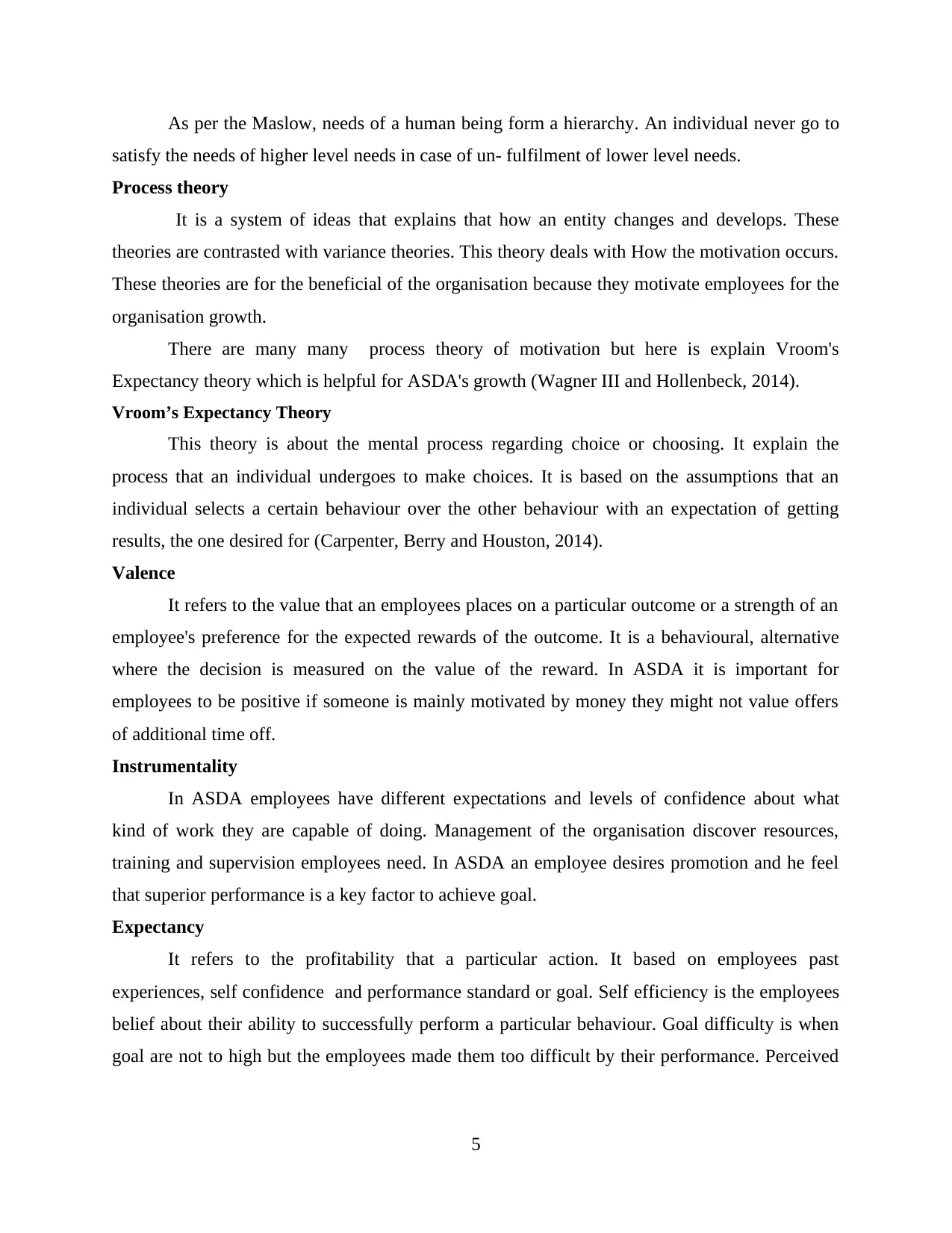
As per the Maslow, needs of a human being form a hierarchy. An individual never go to
satisfy the needs of higher level needs in case of un- fulfilment of lower level needs.
Process theory
It is a system of ideas that explains that how an entity changes and develops. These
theories are contrasted with variance theories. This theory deals with How the motivation occurs.
These theories are for the beneficial of the organisation because they motivate employees for the
organisation growth.
There are many many process theory of motivation but here is explain Vroom's
Expectancy theory which is helpful for ASDA's growth (Wagner III and Hollenbeck, 2014).
Vroom’s Expectancy Theory
This theory is about the mental process regarding choice or choosing. It explain the
process that an individual undergoes to make choices. It is based on the assumptions that an
individual selects a certain behaviour over the other behaviour with an expectation of getting
results, the one desired for (Carpenter, Berry and Houston, 2014).
Valence
It refers to the value that an employees places on a particular outcome or a strength of an
employee's preference for the expected rewards of the outcome. It is a behavioural, alternative
where the decision is measured on the value of the reward. In ASDA it is important for
employees to be positive if someone is mainly motivated by money they might not value offers
of additional time off.
Instrumentality
In ASDA employees have different expectations and levels of confidence about what
kind of work they are capable of doing. Management of the organisation discover resources,
training and supervision employees need. In ASDA an employee desires promotion and he feel
that superior performance is a key factor to achieve goal.
Expectancy
It refers to the profitability that a particular action. It based on employees past
experiences, self confidence and performance standard or goal. Self efficiency is the employees
belief about their ability to successfully perform a particular behaviour. Goal difficulty is when
goal are not to high but the employees made them too difficult by their performance. Perceived
5
satisfy the needs of higher level needs in case of un- fulfilment of lower level needs.
Process theory
It is a system of ideas that explains that how an entity changes and develops. These
theories are contrasted with variance theories. This theory deals with How the motivation occurs.
These theories are for the beneficial of the organisation because they motivate employees for the
organisation growth.
There are many many process theory of motivation but here is explain Vroom's
Expectancy theory which is helpful for ASDA's growth (Wagner III and Hollenbeck, 2014).
Vroom’s Expectancy Theory
This theory is about the mental process regarding choice or choosing. It explain the
process that an individual undergoes to make choices. It is based on the assumptions that an
individual selects a certain behaviour over the other behaviour with an expectation of getting
results, the one desired for (Carpenter, Berry and Houston, 2014).
Valence
It refers to the value that an employees places on a particular outcome or a strength of an
employee's preference for the expected rewards of the outcome. It is a behavioural, alternative
where the decision is measured on the value of the reward. In ASDA it is important for
employees to be positive if someone is mainly motivated by money they might not value offers
of additional time off.
Instrumentality
In ASDA employees have different expectations and levels of confidence about what
kind of work they are capable of doing. Management of the organisation discover resources,
training and supervision employees need. In ASDA an employee desires promotion and he feel
that superior performance is a key factor to achieve goal.
Expectancy
It refers to the profitability that a particular action. It based on employees past
experiences, self confidence and performance standard or goal. Self efficiency is the employees
belief about their ability to successfully perform a particular behaviour. Goal difficulty is when
goal are not to high but the employees made them too difficult by their performance. Perceived
5
Paraphrase This Document
Need a fresh take? Get an instant paraphrase of this document with our AI Paraphraser
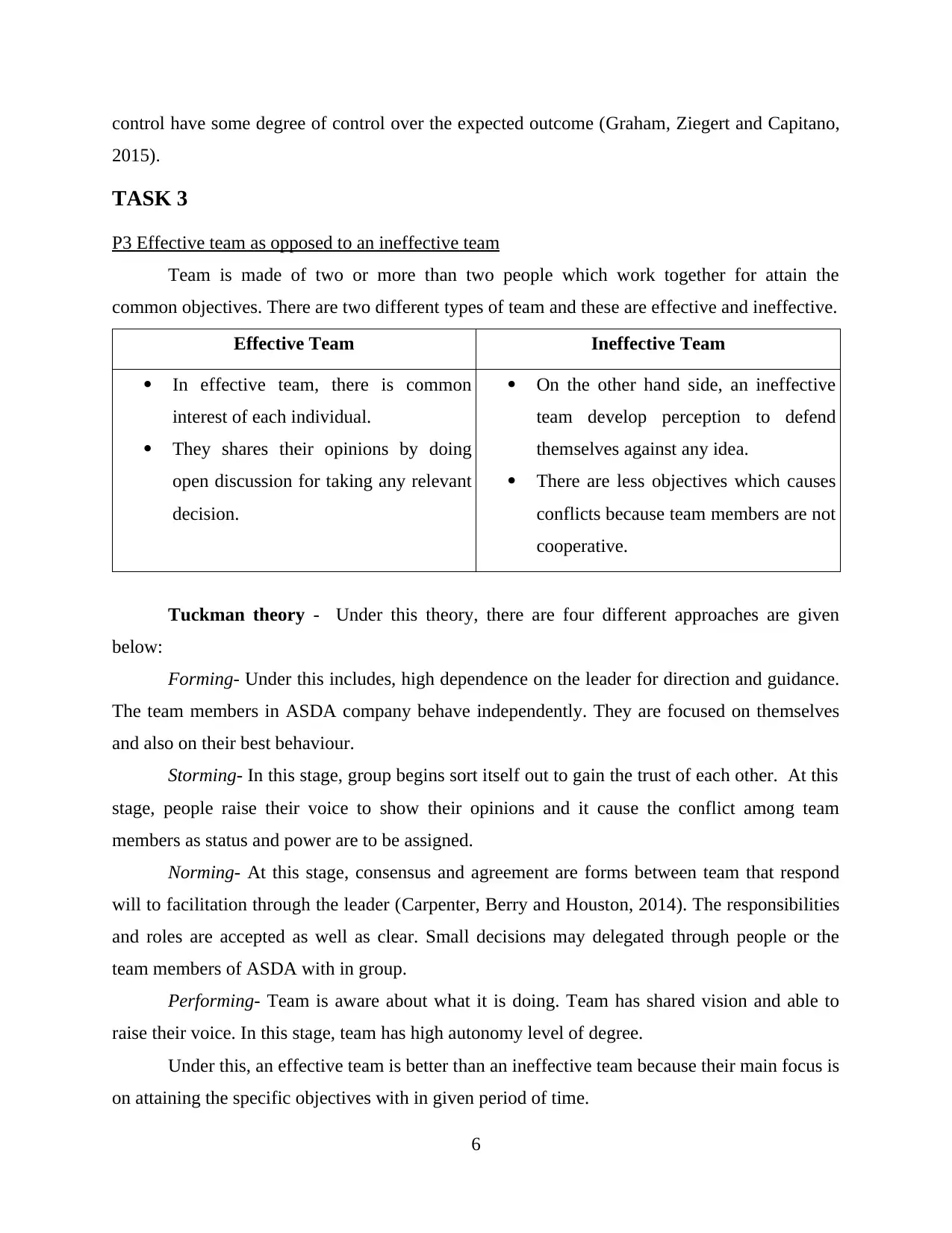
control have some degree of control over the expected outcome (Graham, Ziegert and Capitano,
2015).
TASK 3
P3 Effective team as opposed to an ineffective team
Team is made of two or more than two people which work together for attain the
common objectives. There are two different types of team and these are effective and ineffective.
Effective Team Ineffective Team
In effective team, there is common
interest of each individual.
They shares their opinions by doing
open discussion for taking any relevant
decision.
On the other hand side, an ineffective
team develop perception to defend
themselves against any idea.
There are less objectives which causes
conflicts because team members are not
cooperative.
Tuckman theory - Under this theory, there are four different approaches are given
below:
Forming- Under this includes, high dependence on the leader for direction and guidance.
The team members in ASDA company behave independently. They are focused on themselves
and also on their best behaviour.
Storming- In this stage, group begins sort itself out to gain the trust of each other. At this
stage, people raise their voice to show their opinions and it cause the conflict among team
members as status and power are to be assigned.
Norming- At this stage, consensus and agreement are forms between team that respond
will to facilitation through the leader (Carpenter, Berry and Houston, 2014). The responsibilities
and roles are accepted as well as clear. Small decisions may delegated through people or the
team members of ASDA with in group.
Performing- Team is aware about what it is doing. Team has shared vision and able to
raise their voice. In this stage, team has high autonomy level of degree.
Under this, an effective team is better than an ineffective team because their main focus is
on attaining the specific objectives with in given period of time.
6
2015).
TASK 3
P3 Effective team as opposed to an ineffective team
Team is made of two or more than two people which work together for attain the
common objectives. There are two different types of team and these are effective and ineffective.
Effective Team Ineffective Team
In effective team, there is common
interest of each individual.
They shares their opinions by doing
open discussion for taking any relevant
decision.
On the other hand side, an ineffective
team develop perception to defend
themselves against any idea.
There are less objectives which causes
conflicts because team members are not
cooperative.
Tuckman theory - Under this theory, there are four different approaches are given
below:
Forming- Under this includes, high dependence on the leader for direction and guidance.
The team members in ASDA company behave independently. They are focused on themselves
and also on their best behaviour.
Storming- In this stage, group begins sort itself out to gain the trust of each other. At this
stage, people raise their voice to show their opinions and it cause the conflict among team
members as status and power are to be assigned.
Norming- At this stage, consensus and agreement are forms between team that respond
will to facilitation through the leader (Carpenter, Berry and Houston, 2014). The responsibilities
and roles are accepted as well as clear. Small decisions may delegated through people or the
team members of ASDA with in group.
Performing- Team is aware about what it is doing. Team has shared vision and able to
raise their voice. In this stage, team has high autonomy level of degree.
Under this, an effective team is better than an ineffective team because their main focus is
on attaining the specific objectives with in given period of time.
6
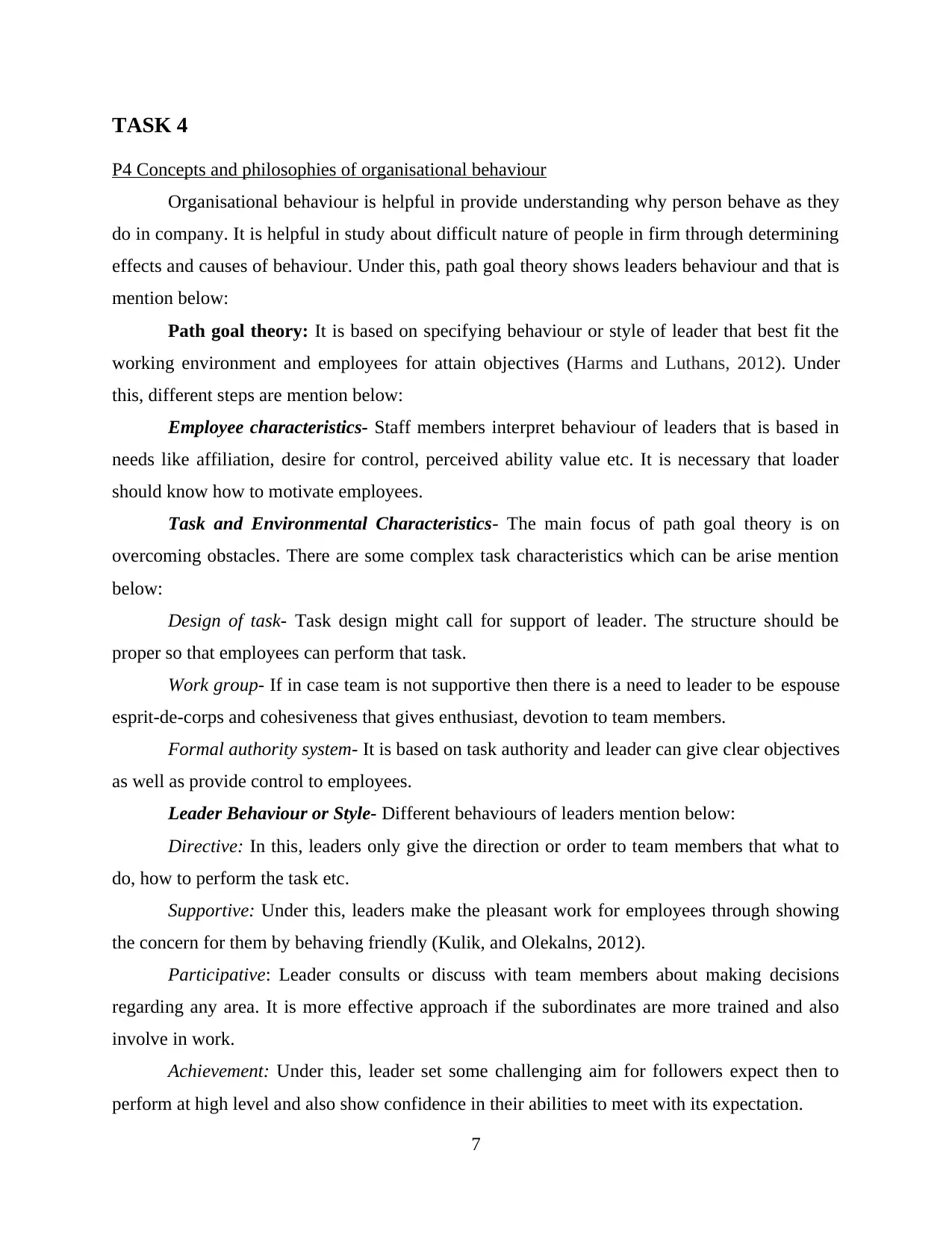
TASK 4
P4 Concepts and philosophies of organisational behaviour
Organisational behaviour is helpful in provide understanding why person behave as they
do in company. It is helpful in study about difficult nature of people in firm through determining
effects and causes of behaviour. Under this, path goal theory shows leaders behaviour and that is
mention below:
Path goal theory: It is based on specifying behaviour or style of leader that best fit the
working environment and employees for attain objectives (Harms and Luthans, 2012). Under
this, different steps are mention below:
Employee characteristics- Staff members interpret behaviour of leaders that is based in
needs like affiliation, desire for control, perceived ability value etc. It is necessary that loader
should know how to motivate employees.
Task and Environmental Characteristics- The main focus of path goal theory is on
overcoming obstacles. There are some complex task characteristics which can be arise mention
below:
Design of task- Task design might call for support of leader. The structure should be
proper so that employees can perform that task.
Work group- If in case team is not supportive then there is a need to leader to be espouse
esprit-de-corps and cohesiveness that gives enthusiast, devotion to team members.
Formal authority system- It is based on task authority and leader can give clear objectives
as well as provide control to employees.
Leader Behaviour or Style- Different behaviours of leaders mention below:
Directive: In this, leaders only give the direction or order to team members that what to
do, how to perform the task etc.
Supportive: Under this, leaders make the pleasant work for employees through showing
the concern for them by behaving friendly (Kulik, and Olekalns, 2012).
Participative: Leader consults or discuss with team members about making decisions
regarding any area. It is more effective approach if the subordinates are more trained and also
involve in work.
Achievement: Under this, leader set some challenging aim for followers expect then to
perform at high level and also show confidence in their abilities to meet with its expectation.
7
P4 Concepts and philosophies of organisational behaviour
Organisational behaviour is helpful in provide understanding why person behave as they
do in company. It is helpful in study about difficult nature of people in firm through determining
effects and causes of behaviour. Under this, path goal theory shows leaders behaviour and that is
mention below:
Path goal theory: It is based on specifying behaviour or style of leader that best fit the
working environment and employees for attain objectives (Harms and Luthans, 2012). Under
this, different steps are mention below:
Employee characteristics- Staff members interpret behaviour of leaders that is based in
needs like affiliation, desire for control, perceived ability value etc. It is necessary that loader
should know how to motivate employees.
Task and Environmental Characteristics- The main focus of path goal theory is on
overcoming obstacles. There are some complex task characteristics which can be arise mention
below:
Design of task- Task design might call for support of leader. The structure should be
proper so that employees can perform that task.
Work group- If in case team is not supportive then there is a need to leader to be espouse
esprit-de-corps and cohesiveness that gives enthusiast, devotion to team members.
Formal authority system- It is based on task authority and leader can give clear objectives
as well as provide control to employees.
Leader Behaviour or Style- Different behaviours of leaders mention below:
Directive: In this, leaders only give the direction or order to team members that what to
do, how to perform the task etc.
Supportive: Under this, leaders make the pleasant work for employees through showing
the concern for them by behaving friendly (Kulik, and Olekalns, 2012).
Participative: Leader consults or discuss with team members about making decisions
regarding any area. It is more effective approach if the subordinates are more trained and also
involve in work.
Achievement: Under this, leader set some challenging aim for followers expect then to
perform at high level and also show confidence in their abilities to meet with its expectation.
7
⊘ This is a preview!⊘
Do you want full access?
Subscribe today to unlock all pages.

Trusted by 1+ million students worldwide
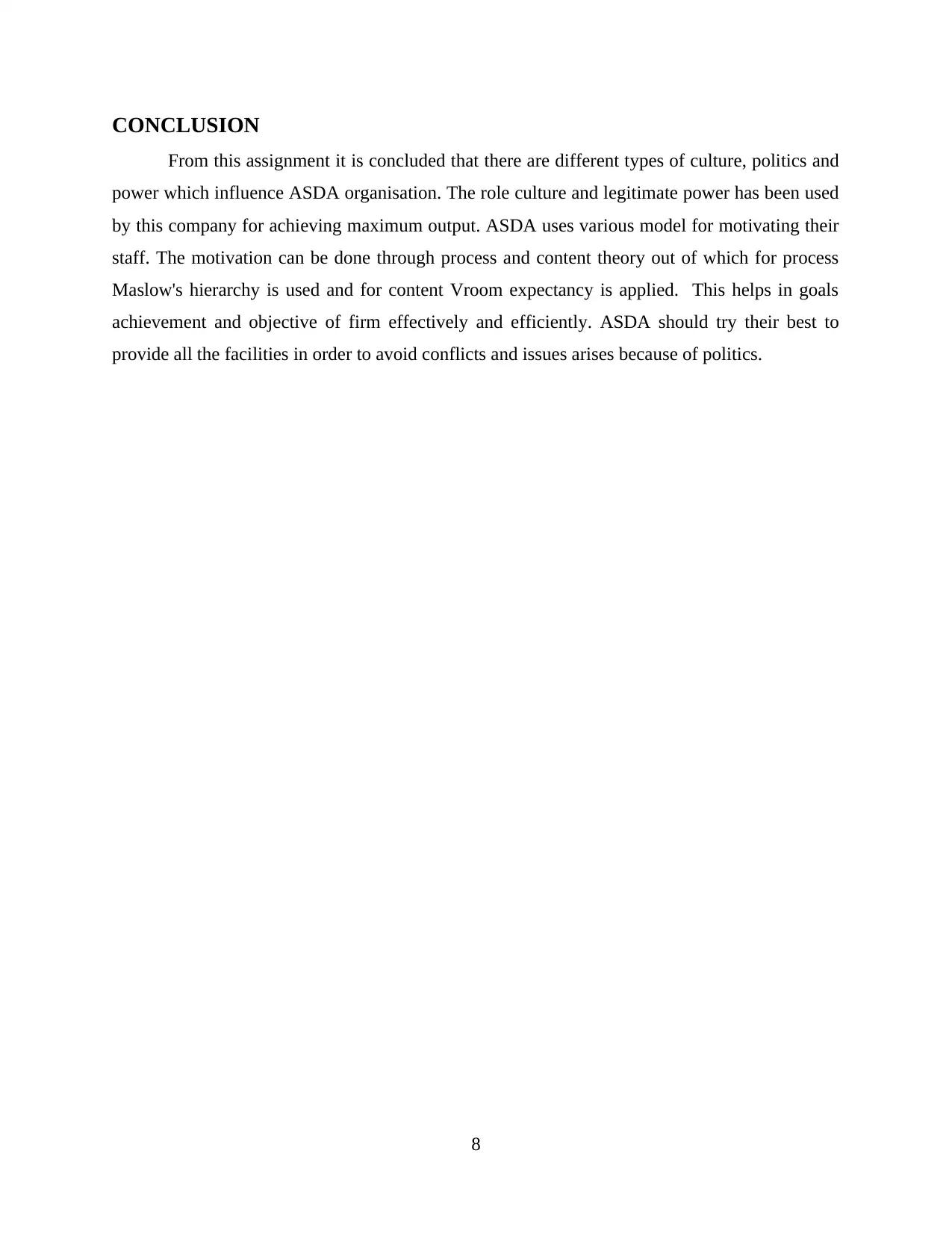
CONCLUSION
From this assignment it is concluded that there are different types of culture, politics and
power which influence ASDA organisation. The role culture and legitimate power has been used
by this company for achieving maximum output. ASDA uses various model for motivating their
staff. The motivation can be done through process and content theory out of which for process
Maslow's hierarchy is used and for content Vroom expectancy is applied. This helps in goals
achievement and objective of firm effectively and efficiently. ASDA should try their best to
provide all the facilities in order to avoid conflicts and issues arises because of politics.
8
From this assignment it is concluded that there are different types of culture, politics and
power which influence ASDA organisation. The role culture and legitimate power has been used
by this company for achieving maximum output. ASDA uses various model for motivating their
staff. The motivation can be done through process and content theory out of which for process
Maslow's hierarchy is used and for content Vroom expectancy is applied. This helps in goals
achievement and objective of firm effectively and efficiently. ASDA should try their best to
provide all the facilities in order to avoid conflicts and issues arises because of politics.
8
Paraphrase This Document
Need a fresh take? Get an instant paraphrase of this document with our AI Paraphraser
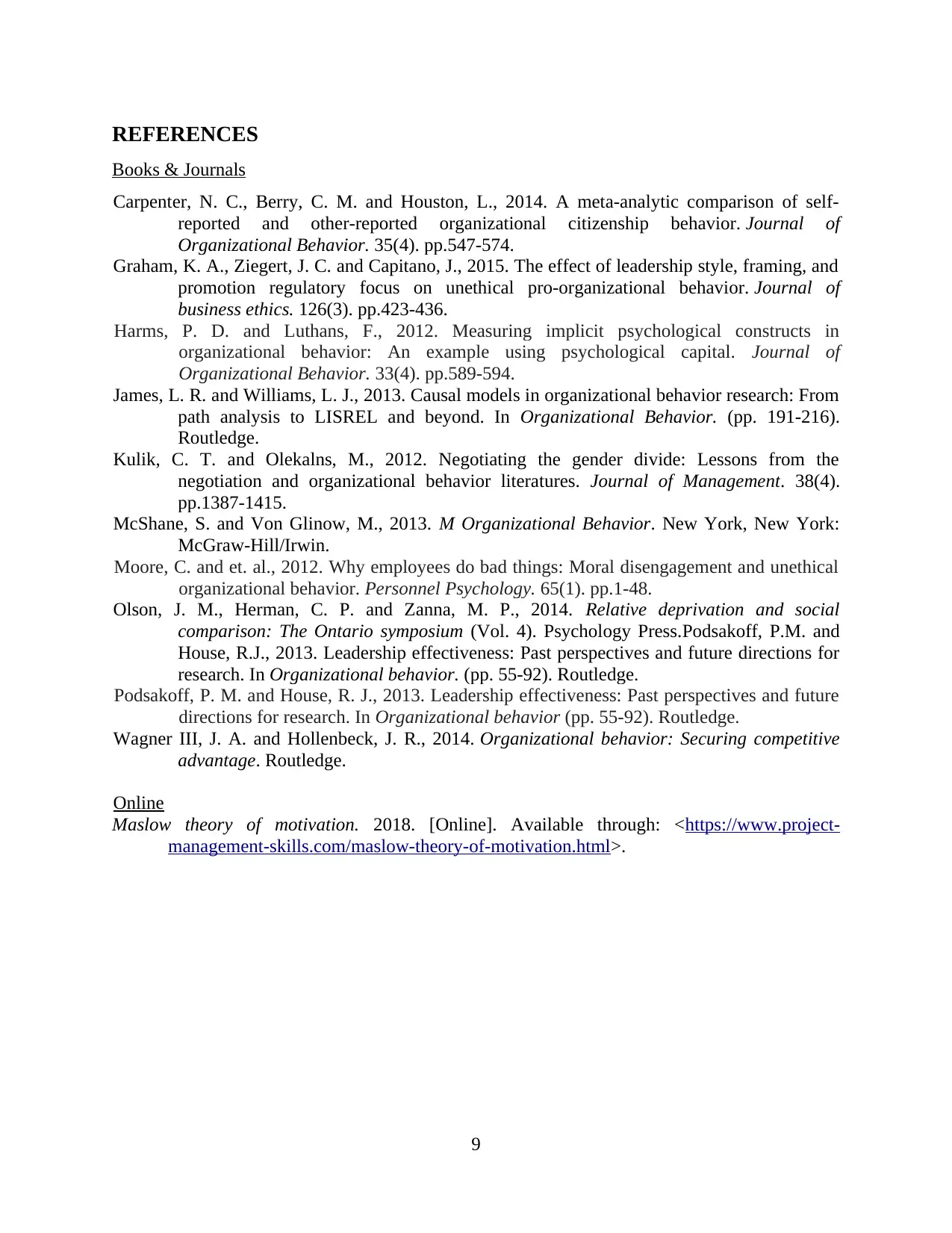
REFERENCES
Books & Journals
Carpenter, N. C., Berry, C. M. and Houston, L., 2014. A meta‐analytic comparison of self‐
reported and other‐reported organizational citizenship behavior. Journal of
Organizational Behavior. 35(4). pp.547-574.
Graham, K. A., Ziegert, J. C. and Capitano, J., 2015. The effect of leadership style, framing, and
promotion regulatory focus on unethical pro-organizational behavior. Journal of
business ethics. 126(3). pp.423-436.
Harms, P. D. and Luthans, F., 2012. Measuring implicit psychological constructs in
organizational behavior: An example using psychological capital. Journal of
Organizational Behavior. 33(4). pp.589-594.
James, L. R. and Williams, L. J., 2013. Causal models in organizational behavior research: From
path analysis to LISREL and beyond. In Organizational Behavior. (pp. 191-216).
Routledge.
Kulik, C. T. and Olekalns, M., 2012. Negotiating the gender divide: Lessons from the
negotiation and organizational behavior literatures. Journal of Management. 38(4).
pp.1387-1415.
McShane, S. and Von Glinow, M., 2013. M Organizational Behavior. New York, New York:
McGraw-Hill/Irwin.
Moore, C. and et. al., 2012. Why employees do bad things: Moral disengagement and unethical
organizational behavior. Personnel Psychology. 65(1). pp.1-48.
Olson, J. M., Herman, C. P. and Zanna, M. P., 2014. Relative deprivation and social
comparison: The Ontario symposium (Vol. 4). Psychology Press.Podsakoff, P.M. and
House, R.J., 2013. Leadership effectiveness: Past perspectives and future directions for
research. In Organizational behavior. (pp. 55-92). Routledge.
Podsakoff, P. M. and House, R. J., 2013. Leadership effectiveness: Past perspectives and future
directions for research. In Organizational behavior (pp. 55-92). Routledge.
Wagner III, J. A. and Hollenbeck, J. R., 2014. Organizational behavior: Securing competitive
advantage. Routledge.
Online
Maslow theory of motivation. 2018. [Online]. Available through: <https://www.project-
management-skills.com/maslow-theory-of-motivation.html>.
of Motivation
9
Books & Journals
Carpenter, N. C., Berry, C. M. and Houston, L., 2014. A meta‐analytic comparison of self‐
reported and other‐reported organizational citizenship behavior. Journal of
Organizational Behavior. 35(4). pp.547-574.
Graham, K. A., Ziegert, J. C. and Capitano, J., 2015. The effect of leadership style, framing, and
promotion regulatory focus on unethical pro-organizational behavior. Journal of
business ethics. 126(3). pp.423-436.
Harms, P. D. and Luthans, F., 2012. Measuring implicit psychological constructs in
organizational behavior: An example using psychological capital. Journal of
Organizational Behavior. 33(4). pp.589-594.
James, L. R. and Williams, L. J., 2013. Causal models in organizational behavior research: From
path analysis to LISREL and beyond. In Organizational Behavior. (pp. 191-216).
Routledge.
Kulik, C. T. and Olekalns, M., 2012. Negotiating the gender divide: Lessons from the
negotiation and organizational behavior literatures. Journal of Management. 38(4).
pp.1387-1415.
McShane, S. and Von Glinow, M., 2013. M Organizational Behavior. New York, New York:
McGraw-Hill/Irwin.
Moore, C. and et. al., 2012. Why employees do bad things: Moral disengagement and unethical
organizational behavior. Personnel Psychology. 65(1). pp.1-48.
Olson, J. M., Herman, C. P. and Zanna, M. P., 2014. Relative deprivation and social
comparison: The Ontario symposium (Vol. 4). Psychology Press.Podsakoff, P.M. and
House, R.J., 2013. Leadership effectiveness: Past perspectives and future directions for
research. In Organizational behavior. (pp. 55-92). Routledge.
Podsakoff, P. M. and House, R. J., 2013. Leadership effectiveness: Past perspectives and future
directions for research. In Organizational behavior (pp. 55-92). Routledge.
Wagner III, J. A. and Hollenbeck, J. R., 2014. Organizational behavior: Securing competitive
advantage. Routledge.
Online
Maslow theory of motivation. 2018. [Online]. Available through: <https://www.project-
management-skills.com/maslow-theory-of-motivation.html>.
of Motivation
9

10
⊘ This is a preview!⊘
Do you want full access?
Subscribe today to unlock all pages.

Trusted by 1+ million students worldwide
1 out of 12
Related Documents
Your All-in-One AI-Powered Toolkit for Academic Success.
+13062052269
info@desklib.com
Available 24*7 on WhatsApp / Email
![[object Object]](/_next/static/media/star-bottom.7253800d.svg)
Unlock your academic potential
Copyright © 2020–2025 A2Z Services. All Rights Reserved. Developed and managed by ZUCOL.



